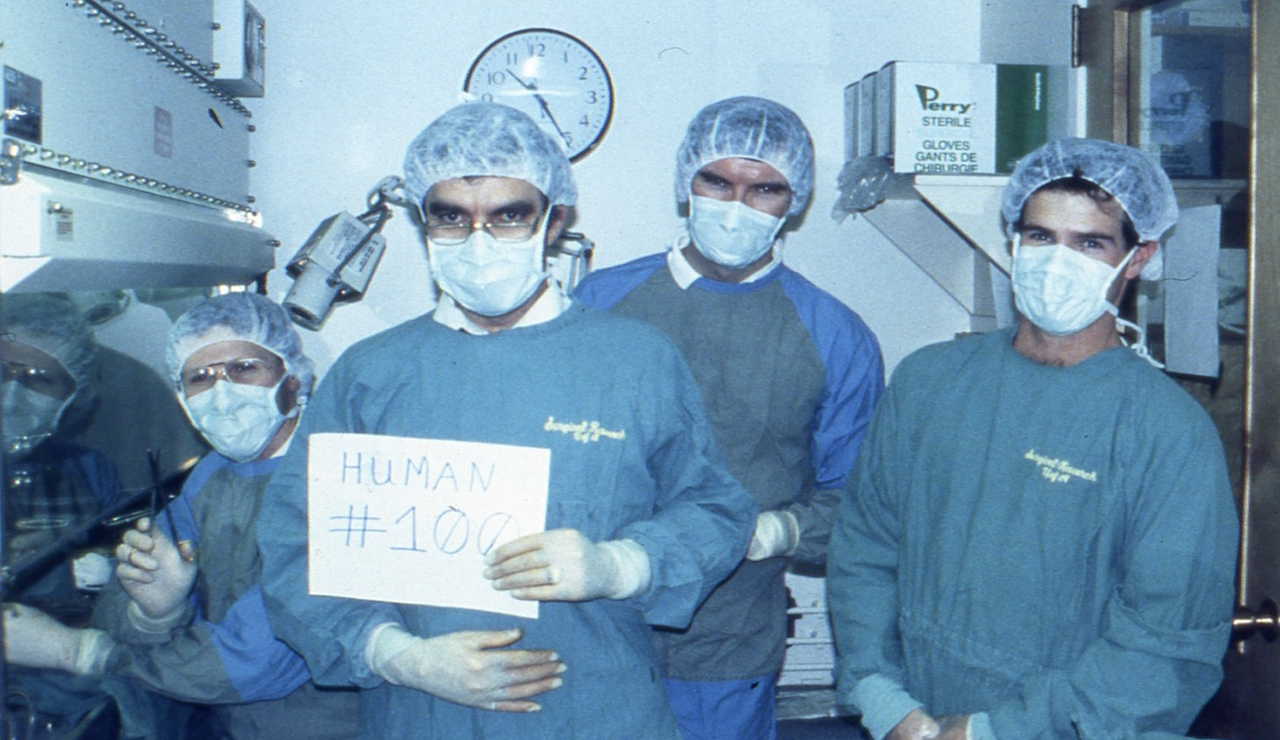Alumnus looks back on early years of UAlberta diabetes research
Sasha Roeder Mah - 11 December 2020

This photo, taken on the eve of Canada's first islet transplant, shows, from left, Garth Warnock, Ray Rajotte, Mark Evans and Dwayne Ellis, senior research technician
Imagine spending years in the lab, working single-mindedly toward a cure for one of the world’s most common diseases, then not only seeing that research translated into success at the bedside, but seeing it in someone you know.
That’s what happened for Garth Warnock.
Now professor emeritus of surgery at the University of British Columbia, Warnock spent many years with the University of Alberta’s Faculty of Medicine & Dentistry, obtaining three degrees (’74 BScMed,’76 MD and ’83 MSc) and completing a surgical residency before returning as a faculty member in 1985. What brought him back was the opportunity to continue contributing to globally recognized work being done in the area of diabetes research. And it was while working in that area that Warnock experienced the highlight of his career.
Early one morning in 1990, Warnock and his team had just spent another sleepless night in the lab, meticulously separating insulin-producing cells from a donor pancreas. “Going through that laborious process we sometimes literally fell asleep on top of our test tubes,” he recalls with a laugh. The next morning, they would transplant that half-teaspoonful of islet cells—together with similarly processed frozen-thawed cells from other donors—into a third patient in the U of A ‘s first-in-Canada islet transplant program for Type 1 diabetes.
“In the morning, I went to share the news with the third patient,” recalls Warnock, “and imagine our surprise to see each other in a new context. Our daughters were good friends in the same ballet class! Not only that, but it was Mother’s Day, too.” That gift of islet cells enabled the woman to become the first documented person in the world to stop insulin for two and a half years. “You couldn’t get a more exciting story,” says Warnock.
For Warnock, memories like this from his years as a diabetes researcher are as fresh as if they happened yesterday. He still remembers the first time he managed to separate purified insulin-producing cells from a donor pancreas, several years after returning as a faculty member. “I ran to (former supervisor and then colleague) Ray Rajotte with this test tube and I remember saying, ‘Can you believe this tiny amount of tissue can actually prevent a person from being diabetic?!’ ”
What will also forever remain is the gratitude Warnock felt toward those selfless families who, in the early years, consented to donate their loved ones’ pancreases to the team’s research.
“To get us to the very first human islet transplant in Canada in 1989, more than 100 organ donor pancreases were painstakingly processed,” he says. “It’s really important to acknowledge the altruism behind those donations; they were such valuable gifts.”
Planting the seeds
Years earlier, just beginning his bachelor’s degree, Warnock never dreamed he would be part of such life-changing work. But at some point during his surgical training at the U of A, he discovered a love for research and, when he embarked on his MSc, he almost accidentally found his way to diabetes as a focus. What drew him was the supervisors he’d get to work with, including Rajotte, founder of the Islet Transplant Group and a major figure in the development of the Edmonton Protocol.
Along with Rajotte, what kept Warnock at the U of A for his master’s degree and what ultimately brought him back to join the faculty was the generous access to peer-review funding from the provincial government. “It was really exciting to me that the Alberta Heritage Foundation for Medical Research provided world-class, state-of-the-art research support,” Warnock recalls.
“What was also attractive to me about the University of Alberta from the very beginning,” he continues, “was the reputation it had for the very, very high quality of clinical education and specialty training. It never really occurred to me to look elsewhere.”
As his educational journey progressed, one of Warnock’s most treasured mentors, Tom Williams, taught him to value the ripple effect a balanced approach to training can have. “Dr. Williams taught me that in the operating room, you can help one person. But if you’re also training students, you can help hundreds more people by sharing knowledge. And if you also conduct research, that can help countless more.”
Warnock calls this blend of clinical work, teaching and research the “three-legged stool” upon which a solid career can sit, and he has loved every minute of all of it. His commitment goes beyond a love of variety, however; to Warnock, it is a “fundamental duty” for health professionals to bring knowledge from bench to bedside and back again.
These days, as he looks back on his varied and fulfilling career, Warnock is inclined to speak more in terms of gratitude than pride. “It was a remarkable experience to see the hope and the happiness,” in those first transplant recipients, he says, “and I’m thankful for the very brave first five people who had the courage to have the transplants and those who donated so selflessly.”
“What’s meaningful to me is that I’ve used my career to contribute to society.”